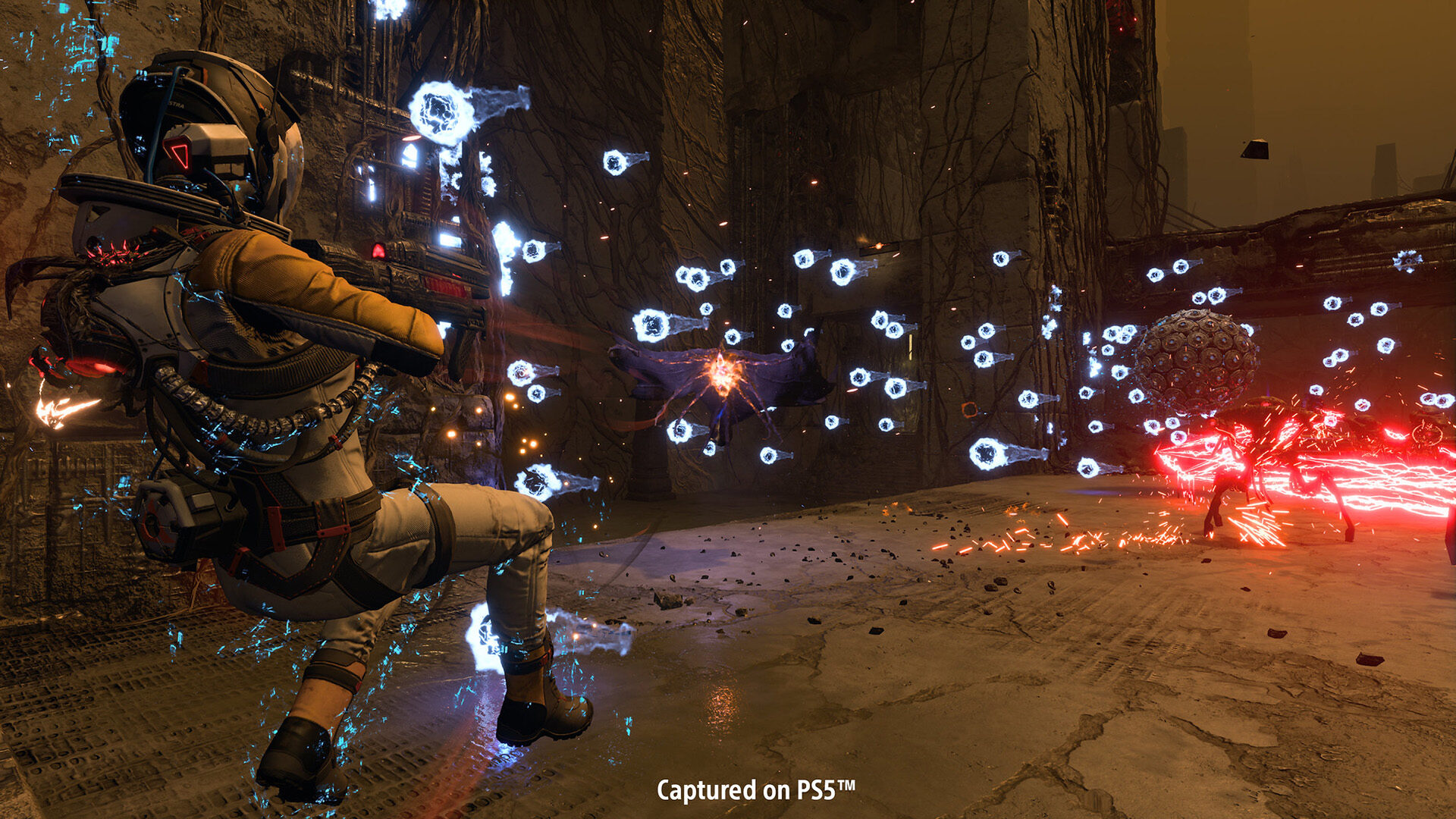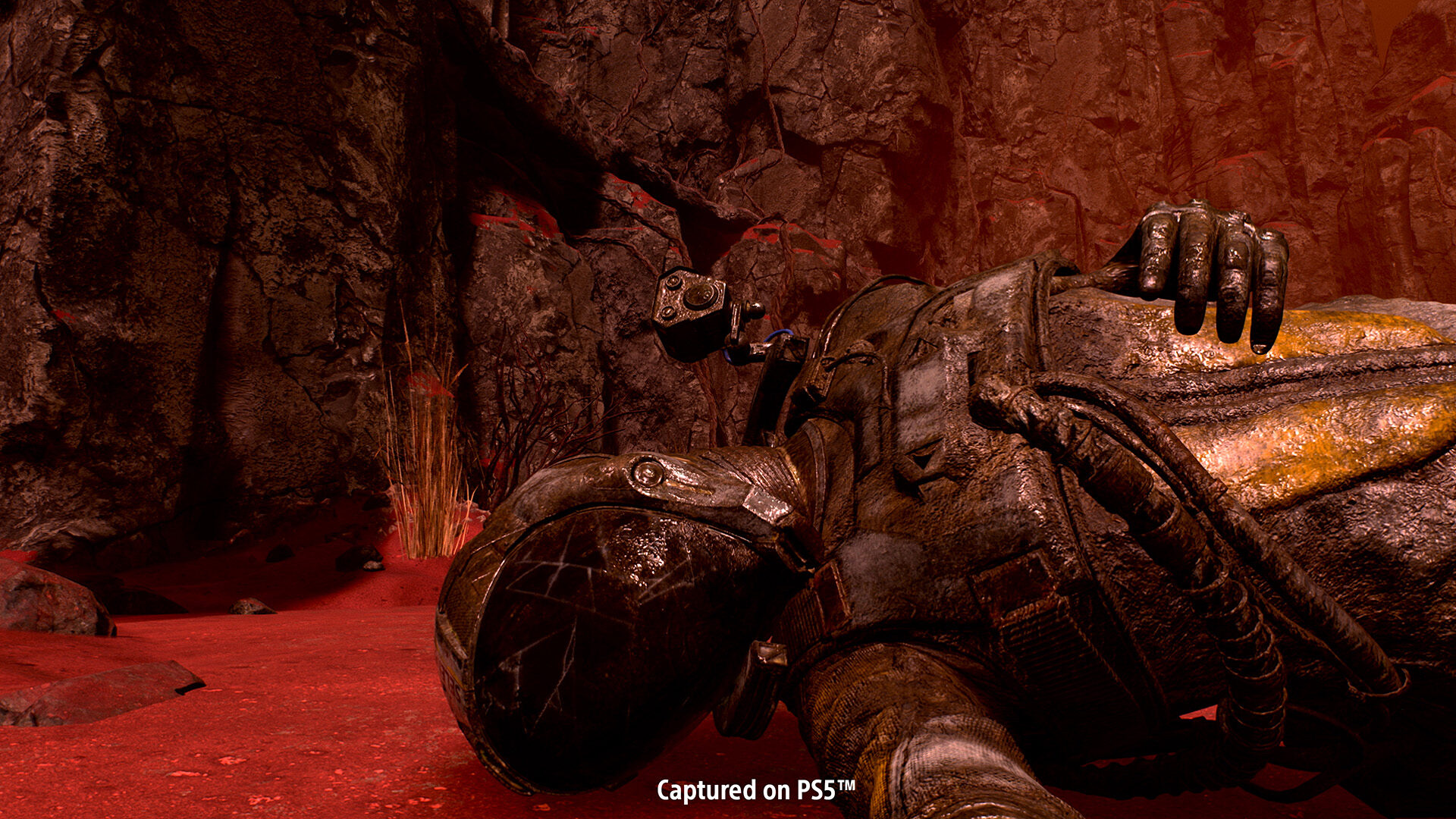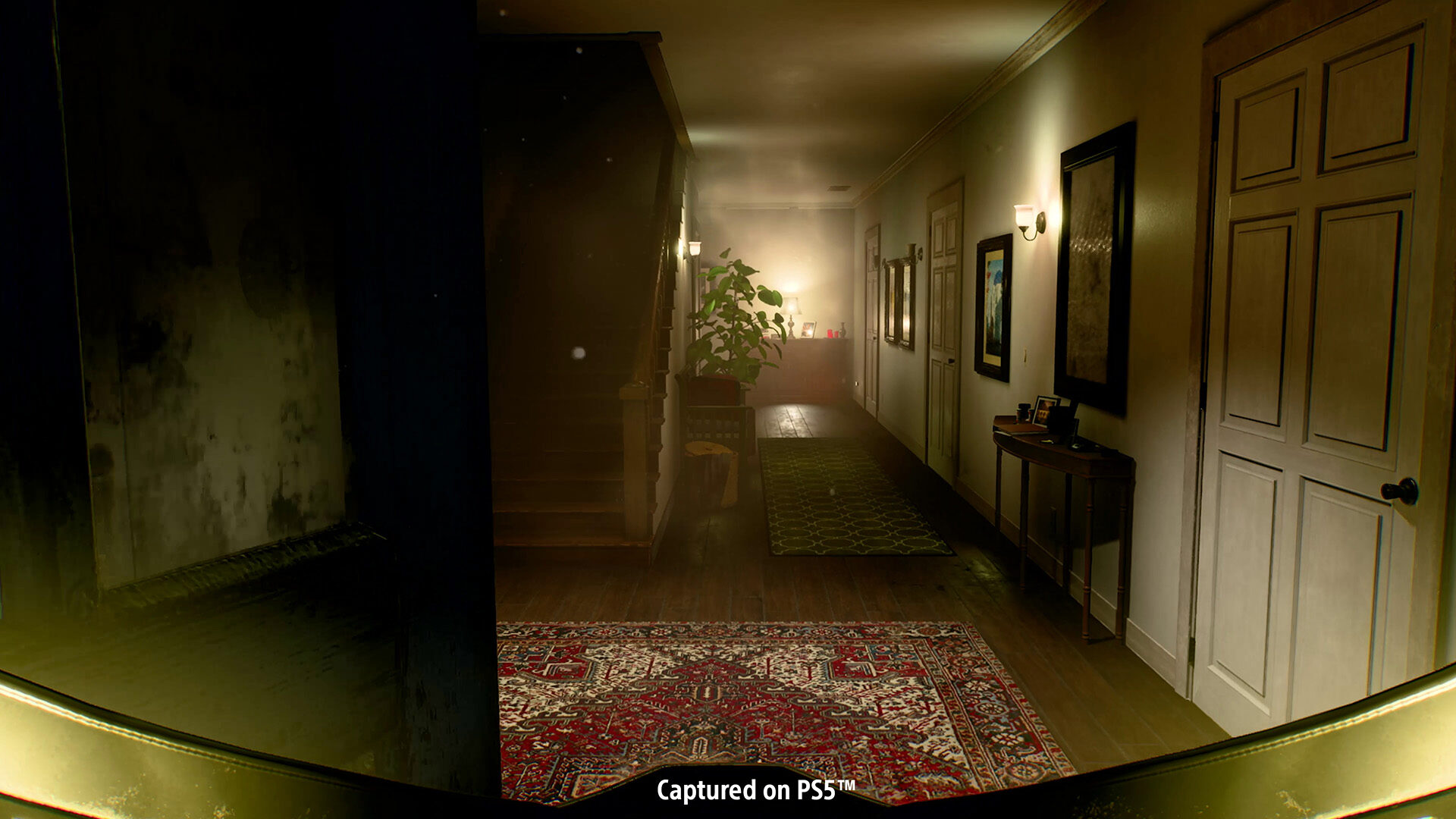It feels almost wrong to tell you too much about Returnal. Though the game does have some optional tutorials buried away on the pause menu, the brilliance of its design is that it conveys nearly everything you need to know to master gameplay unobtrusively, through experimentation and trial and error.
You’re Selene, an interstellar scout on a mission for the organization Astra. You crash land on the planet of Atropos, investigating a mysterious signal called White Shadow. You find your gun on your own corpse. You restart at the beginning the first time you die, with the maps and enemies shuffled around. Beyond that, it’s pretty much up to you to push forward and figure out gameplay for yourself. Even after you beat all six areas and get to the credits for the first time, there’s still a lot more to discover if you want to reach the real ending. Having successfully plunged through all that myself after going in blind, I think it’d take some of the magic away if I said too much.
So let’s start here: If a challenging, bullet-hell-inspired, third-person shooter roguelike sounds like your jam, Returnal’s gameplay is very much worth your time. Feel free to be a bad reader and skip ahead to the score, then go buy it. But if you need more, rest assured that I’ll do my best to keep the magic intact throughout the rest of the review.
What sets Returnal apart from most other roguelikes I’ve played, even great ones, is that Housemarque doesn’t allow gameplay to take a backseat. I love Hades, I love The Binding of Isaac, but I don’t know if I’d say that, from a purely mechanical standpoint, either one of those games is a world-class action experience.
Returnal, though, is one of the most engaging third-person shooters I’ve played in the last decade. Controls are tight, thanks to a smooth and steady framerate of 60 FPS, and Selene’s core moveset of dodging, sprinting, and jumping links together beautifully. Though I have some clear preferences among the varied weapon types, the guns are satisfying to shoot, and there’s a rhythmic quality to firing and even reloading them. (The game essentially cribs Gears of War’s active reload. That’s not a slight. The real crime here is that more games haven’t already stolen it.)
Though each run in Returnal is fairly long for an action roguelike—you can quite honestly spend more than two hours on one attempt if you’re thorough—and the difficulty ramps up to a considerable degree in the late stages of each playthrough, dying never feels unfair, because the game offers you such control over every fight. Enemy attacks are readable and telegraphed, and Housemarque appears to have coded in some clever rules about what can attack you and when. You’re not going to get ambushed from behind without plenty of notice, and enemies will subtly wait their turn to make sure you’re never overwhelmed. It’s possible to clear entire fights, even some of the later boss fights, without taking a single hit.

In fact, you’ll probably have to if you want to succeed regularly, since so much of the game is designed as a positive feedback loop for good performance. Kill enemies without being hit, and you’ll raise your “Adrenaline Level,” gaining buffs to things like the rate at which you earn weapon XP and the amount of currency enemies drop on death. Even more clever is how the game handles health pickups you find scattered around the map. If you’re at full health, each one you find becomes a different sort of pickup—resin—that contributes to leveling up your max health. This is a game that rewards not just skill, but mastery. An exceptional run puts you in absurdly better shape to survive than even a decent one.
The result is an immensely satisfying learning curve. Returnal’s best moments are when you briefly snap back into your conscious mind and look at what’s actually happening. You realize that the entire screen is covered in striking, colorful patterns that want to kill you. And there you are, in the middle of that beautiful mess, floating through it almost effortlessly. Jumping, dodging, strafing, all the while hammering on the trigger.
This is combat expertly designed to achieve a flow state. You learn to play Returnal with your lizard brain, then your hands take over. In the most intense fights, you have to just feel it, because if you stop to think too hard, you’re already as good as dead.
Like any roguelike, Returnal expands beyond simple combat with a vast number of randomized items, coupled with Metroid-style permanent upgrades that allow you to access new areas of the map. As you play through, you’ll constantly expand the loot pool with more single-use pickups, artifacts that confer benefits for the rest of the run, and new weapon types that mix up gameplay.
There are far too many aspects to cover them all in depth here, even if I wanted to. But I would like to highlight two of the more brilliant additions. First are parasites, which latch onto you quasi-permanently on pickup and offer both a benefit and a debuff, forcing you to constantly make difficult trade-offs. Is it worth healing every time you kill an enemy if you can no longer pick up healing items you find in the world? Though there are a few ways to detach a parasite you decide you don’t like it, there’s no way to detach just one specific parasite if you have more than one on you.
Then there’s the malignancy system. Essentially, some of the pickups you find and chests you come across will be malignant. There’s a chance, if you pick them up or open them, that you’ll get the item consequence-free. But there’s also a chance that they’ll trigger a suit malfunction, which debuffs you until you fulfill a specific fix requirement. For example, you might do half damage while at full health until you kill 15 enemies, or you might be unable to pick up new weapons until you spend your currency to fabricate an item at a shop. And if you get more than two malfunctions at any given time, the game will start randomly destroying items in your inventory. What’s more, some enemy attacks also have a chance to cause malfunctions, so it’s not like you can walk around with a full set of two and feel completely safe as long as you don’t pick up more malignant items. On paper, it might not sound that special. In practice, it’s nothing short of genius, another layer of smart complexity in a game that’s rich with them.
The aspect of gambling, in both the malignancy system and parasites, is also a great mirror for the game’s action. So often a run will collapse because you get too confident, push too hard or too fast, and lose the rhythm of a fight. The item system essentially duplicates this, shifting it from the level of tactics to strategy. There’s an aspect of this in every great roguelike to some degree, but I’ve never felt it more cleanly or fully realized than in Returnal.

But if I have no real complaints about the gameplay, I have pretty much nothing but complaints about the story. Or, more accurately, one really big complaint: It’s just a mess of vague nonsense. There are a few incredibly neat ideas, but they ultimately go nowhere. Maybe there’s an interesting story here, but Housemarque didn’t bother to actually tell it.
Yes, story is hardly the most important thing in a roguelike, but Returnal privileges its narrative, even going so far as to add enigmatic first-person sequences that explore, in the loosest sense of the word, what’s going on, along with plenty of cutscenes and optional material.
The thing is, if you’re going to pile on mysterious imagery in the opening moments and at regular intervals afterward, you have to eventually tie it together into something approaching a full picture of the truth. Mysteries need solutions, even if they’re only partial. At the very least, if you’re trying to be all postmodern and dickishly opaque, you need to clearly signpost that the mystery is the point, maaan. You have to give the reader or the viewer or the player something to hold onto. Even Twin Peaks, in all its creamed corn weirdness, told us who killed Laura Palmer.
The fact that I’ve played through all the content in Returnal multiple times, all the way through to the second hidden ending, and still have no concrete answers about the basic plot is ridiculous. I’m not talking about minor mysteries or lore specifics. Here are some spoiler-free questions I can’t confidently answer after 46 hours with the game: Who is Selene? What are some of her personality traits? What was her life like before the game? Why and how did she get trapped in a loop on Atropos? Has anyone else ever looped before her? What is the meaning of “White Shadow”? Are X and Y the same person? Does Y even exist? Did anything I played through actually even happen?

To be clear, I’ve found and read or listened to nearly all of the narrative collectibles: text files, audio logs, and 3D murals. Maybe one of the few I haven’t found holds the key to everything. Maybe—though this would be even more insane—the answers are in the tiny text snippets you can unlock on the database screen by killing specific enemy types and using specific items dozens, if not hundreds, of times each. But I doubt it, because all the supplementary material I’ve unlocked so far is just as withholding. You have to put a huge time investment into the game, battling against a lot of randomness to get them. When you finally do, you don’t get solutions—you get more puzzle pieces. Who knows if they’ll fit together once you have them all?
Needless to say, this is a terrible approach. Why should the thing a game keeps furthest from the player be a basic understanding of its plot? Even if the valiant wiki editors of the world can someday piece together a compelling theory of what Housemarque intended, that won’t suddenly transform this goopy mess into good storytelling or strong narrative design, not any more than throwing a pile of bricks into an empty lot is great architecture.
Maybe the idea was to mirror the lack of hand-holding that makes the gameplay so great, but it doesn’t work. At all. This isn’t Dark Souls, where the fun is deciphering vague clues about the history of a complex world. In those games, the mystery provides added depth on top of a story with its own characters and objectives and resolution. This, by contrast, is a simple story with very few characters that ultimately fails to deliver concrete answers about pretty much anything that happens. Breadcrumbs cannot be sustenance.
But at the same time, the storytelling, misfire though it is, is hardly all the game has to offer. Does it get under my skin? Yes, as you can probably tell by the many paragraphs I’ve spent ranting about it. But I’m not sure I can honestly say it spoils the experience so much as detracts from an otherwise engaging shooter.
So here’s my advice: Play Returnal. Revel in its excellent action. Embrace the challenge. Beat the game. Beat it again. Master it. But always, always treat the story stuff as tone, as mood, as a kind of visual soundtrack.
Feel it, but don’t think too hard about it. Because if you do, you’re already as good as dead.
All images courtesy of Sony Interactive Entertainment and Housemarque.
|
★★★★☆
Returnal excellently blends third-person shooter gameplay with bullet-hell style enemies and roguelike elements to craft a fun, challenging action game that you’ll have a blast learning to master. The only real shame is that the action is yoked to a story that mistakes being vague for being smart and interesting. |
Developer Housemarque Publisher Sony Interactive Entertainment ESRB T - Teen Release Date 04.30.2021 |
| Returnal is available on PlayStation 5. Primary version played was for PS5. Product was provided by Sony Interactive Entertainment for the benefit of this coverage. EGM reviews on a scale of one to five stars. | |
